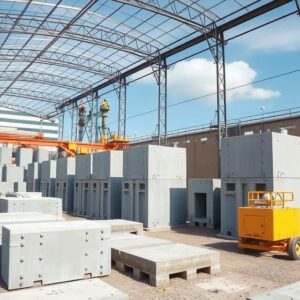
When you think of modern construction, what comes to mind? Speed, strength, and sustainability. One material that hits all three targets is precast concrete—a game-changer in both large-scale infrastructure and stylish architectural design.
In this guide, we’ll break down what precast concrete is, explore its various types, highlight its key benefits, and showcase its real-world applications that are shaping skylines and streamlining projects across the globe.
What Is Precast Concrete?
Precast concrete is a construction product produced by casting concrete in a reusable mold or form, cured in a controlled environment, and then transported to the construction site. Unlike traditional concrete, which is poured and cured on-site, precast components are made off-site and delivered ready to install.
It’s a method that blends quality control, efficiency, and innovation, allowing construction teams to accelerate timelines without sacrificing structural integrity.

Types of Precast Concrete
Here’s a quick overview of the most commonly used types of precast concrete:
- Precast Beams and Girders
Ideal for bridges and large buildings. They come in various shapes like I-beams and box girders for optimal load support.
- Precast Slabs
Used for floors and roofs, including hollow core slabs and solid slabs, known for reducing on-site labor and time.
- Precast Walls
These include solid walls, sandwich walls (with insulation in the center), and cladding panels that add strength and aesthetic appeal to buildings.
- Precast Columns and Piers
Engineered for vertical support in buildings, flyovers, and piers providing rapid and stable installation.
- Precast Stairs and Landings
Ready-made staircases that save weeks of manual labor and offer consistent quality.
- Precast Pipes and Manholes
Used extensively in drainage and sewage systems, ensuring durability and resistance to environmental wear.

Key Benefits of Precast Concrete
Why are more engineers, architects, and contractors turning to precast? Here are the standout advantages:
Faster Construction Timelines
Since elements are pre-made, on-site assembly is quicker. It also reduces delays due to weather, as the majority of production happens indoors.
Superior Quality Control
Factory-controlled casting ensures higher consistency, strength, and finish compared to site-poured concrete.
Design Versatility
From structural components to decorative facades, precast concrete supports a wide range of architectural designs.
Durability & Strength
Precast concrete withstands fire, weather, and wear better than many traditional materials, leading to longer life spans with minimal maintenance.
Sustainability
Precast production can reduce waste, lower energy usage, and incorporate recycled materials aligning with green building standards like LEED certification.
Cost Efficiency
While the upfront cost may be higher, the savings in labor, materials, and time make precast concrete a smart long-term investment.
Real-World Applications of Precast Concrete
Infrastructure
Used in bridges, tunnels, flyovers, and railway platforms. Precast concrete accelerates delivery and improves structural performance.
Commercial Buildings
From shopping malls to office towers, precast panels enhance speed and aesthetics, often replacing brick-and-mortar walls.
Residential Housing
Modular precast units are revolutionizing low-cost housing and apartment projects by enabling mass production at high speed.
Educational & Institutional Facilities
Schools and hospitals benefit from precast’s speed and reliability, allowing institutions to open faster and operate more safely.
Urban Landscaping
Benches, planters, pavers, and retaining walls precast is a staple in modern urban design.
Is Precast Concrete Right for Your Project?
If your goal is to build faster, smarter, and stronger, then yes, precast concrete is likely the perfect fit. Whether you’re managing a megaproject or developing mid-rise housing, precast offers the speed-to-market and durability today’s construction world demands.
Final Thoughts
Precast concrete isn’t just a trend it’s a modern construction solution built for the future. With unmatched versatility, efficiency, and sustainability, it’s no wonder this material is at the forefront of 21st-century development.

